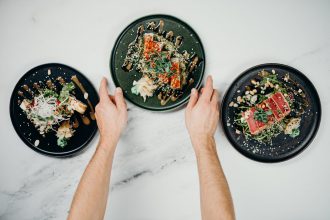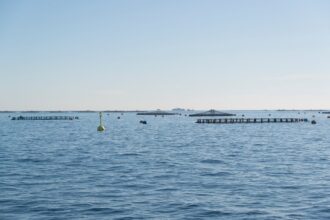B2E Technological Sonar Initiative #29
Exciting updates on the latest advances! Studies, publications, and news on the power of Artificial Intelligence to predict oxygen levels, the revolution in large-scale exploration of tropical algae, and the promising replacement of traditional ingredients with larva flour. In marine biotechnology, discover how fishing by-products can transform into valuable resources, while an extract from macroalgae protects the Senegalese sole against diseases. All in the March edition of B2E CoLAB Technological Sonar Initiative.
AQUACULTURE
Artificial Intelligence to predict dissolved oxygen levels in aquaculture environments
Using the Internet of Things (IoT), researchers at the Shandong Marine Technology Centre in China have proposed a new combined method for accurately predicting oxygen levels that reduces data noise, poor quality and non-linear properties. The proposed model identifies four water quality parameters: electrical conductivity, water temperature, turbidity and water level that are considered important for improving the model’s performance in predicting dissolved oxygen concentration. The authors consider it suitable for non-linear prediction of dissolved oxygen concentration in small sample, non-stationary and commercial aquaculture ponds. Another advantage of this method is the possibility of real-time monitoring of other water quality parameters like atmospheric parameters (temperature, humidity and atmospheric pressure).
Mis Peces
Discover more here.
Assessment of Full-Fat Tenebrio molitor as Feed Ingredient for Solea senegalensis: Effects on Growth Performance and Lipid Profile
Yellow mealworm is considered as one of the most promising protein sources for replacing fish meal in aquafeeds, among other things because is rich in protein, a good source of micronutrients and exhibits low carbon footprint and land usage. The aim of this study was to evaluate the effects of substituting partial plant or marine-derived ingredients with full-fat yellow mealworm meal at two different levels on the growth performance and fatty acid profiles of Senegalese sole. For this purpose, the study tested a control diet and four experimental diets. The addition of insect meal resulted in an increase in growth rate in both cases, whether replacing fish or plant meals. This led to a decrease in muscle total lipid while maintaining the relative levels of n-3 PUFA and DHA, ultimately improving the lipid health indices n-3: n-6.
NCBI
Discover more here.
World’s largest tropical seaweed farm begins operations
Sea6 Energy – an India-based seaweed producer – has launched the world’s first large-scale mechanised tropical seaweed farm. The farm, which covers an area of 1 km2, marks a significant milestone in establishing the scalability of sustainable tropical seaweed cultivation, with potential applications including bio-stimulants, bioplastics, and the continued research and development of renewable chemicals and fuels.
TheFishSite
Discover more here.
LIVING MARINE RESOURCES
Hypolipidemic effect of brown seaweed (Sargassum crassifolium) extract
The purpose of this study was to obtain natural drugs from brown seaweed (Sargassum crassifolium) as antiatherosclerosis candidates through the study of hypolipidemic mechanisms of action. A dyslipidemia mouse experimental animal model was obtained with high-fat feed for 60 days. Subsquently it was verified that the crude fucoidan had antidyslipidemia activity in the dyslipidemia mouse model. Doses of 100, 200, and 400 mg/KgBB of crude fucoidan for 21 days in dyslipidemic rats showed adipose morphological features similar to morphology under normal circumstances and the morphological structure of the liver also decreased in severity and inflammation. The expression of VCAM-1. ICAM-1. MCP-1 mRNA in adipose tissue and liver showed that administration of the 3 treatment doses to the dyslipidemic rats was able to significantly reduce mRNA expression compared to feeding high-fat controls.
NCBI
Discover more here.
The potential of marine worms as replacement aquafeeds
In response to the state of the current process for producing aquafeeds, researcher from the Aarhus University have tested a method of cultivating marine enchytraeid worms for use as an alternative feed source, using decomposing seaweed as a substrate. Utilising a mixture of potting soil and dried and rehydrated seaweed as a growth medium, the researchers managed to reach semi-industrial levels of enchytraeid biomass production, With the ability to be cultivated and fed on industrial organic residues, they offer a promising solution to reduce reliance on marine food sources, thereby alleviating pressure on marine ecosystems. To determine the potential of the worms to act as an alternative aquafeed, the researchers tested the ability of the enchytraeids to provide nutrition for juveniles of six species of cultured fish. Turbot, flounder, and white fish showed significantly better growth when fed on live enchytraeids than on conventional aquafeed.
TheFishSite
Discover more here.
Insect production process using carbon capture
A method for producing insect feed is disclosed, the method comprises: passing a gas stream containing CO2 into a solution containing water and algae, harvesting algae from the solution, and processing the harvested algae to produce insect feed. Also provided is a system for producing algae comprising: a diversion valve connectable to a gas outlet of an industrial plant so as to divert a gas stream from the industrial plant, a photobioreactor containing a solution containing water and algae, and a gas channel fluidly connecting the diversion valve and the photobioreactor, wherein the gas channel is configured to pass the diverted gas stream into the solution contained in the photobioreactor.
WIPO
Discover more here.
MARINE BIOTECHNOLOGY
Gastrointestinal delivery of codfish Skin-Derived collagen Hydrolysates: Deep eutectic solvent extraction and bioactivity analysis
In this study, codfish skin-derived collagen was extracted using a deep eutectic solvent-based extraction, namely, urea: propanoic acid mixture (U:PA; 1:2), followed by enzymatic hydrolysis with alcalase. The resulting bioactive peptides demonstrated notable antioxidant activity and antihypertensive properties. Subsequently, these hydrolysates (39%) were encapsulated in chitosan- tripolyphosphate capsules, which released about 58% of their content, primarily in the intestine, as mimicked in the in vitro model of the gastrointestinal tract.
NCB
Discover more here.
An extract from the macroalgae Ulva improves the protection of Senegalese sole against disease
Ulvan, a marine sulphated polysaccharide from the macroalga Ulva ohnoi, obtained by the hot water and ethanol precipitation method, has shown optimal chemical and structural properties for use as an immunonutrient in aquaculture, with beneficial effects at appropriate concentrations. In addition, toxicity studies showed that this marine sulphated polysaccharide showed no toxicity at concentrations up to 1 milligram per millilitre for 24 hours. Dietary administration of 1% of the ulvan extract for 30 days resulted in a significant improvement in immune response and resistance to bacterial infection in juvenile Senegalese sole.
Mis Peces
Discover more here.
Construction method and use of astaxanthin synthesis pathway in chlamydomonas reinhardtii
Provided are a construction method and use of an astaxanthin synthesis pathway in Chlamydomonas reinhardtii. The construction method comprises the design and assembly of an astaxanthin synthesis module and functional verification of the astaxanthin synthesis module in Chlamydomonas reinhardtii. The finally obtained transgenic astaxanthin synthetic engineering algae strain can realize rapid and cheap production of astaxanthin by means of large-scale culturing.
WIPO
Discover more here.





